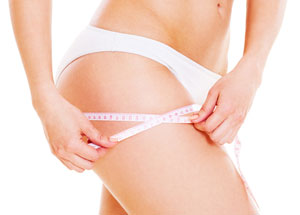Thighs are one of those parts of the body that do not forgive our lack of physical activity or diet sins. However, even when we devoted a lot of time and attention, it is difficult to shape them in a way we would want.
Thigh lift is a procedure aimed at improving the appearance of the middle part of the thighs by removing excess flaccid skin, modeling their shape and giving the right proportions. Some people, despite being on a diet and exercising regularly, tend to accumulate fat in the upper part of the legs- in this case, for better results, the procedure is combined with liposuction of this area.
INDICATIONS FOR THE TREATMENT:
- excess skin in the upper leg area in patients who have lost their skin firmness due to large weight fluctuations
- not sufficiently contracted skin after liposuction
- loose, hanging skin of inner thighs in older people
CONTRAINDICATIONS:
- local skin changes (inflammation, abscesses, infections – until they are cured)
- recent heart attack and stroke, active cancer
- untreated hypertension
- thromboembolic disorders
- blood coagulation disorders
- lymph circulation disorders
- diabetes
- patient’s general poor health
When planning the operation, remember:
- quit (or limit) smoking at least four weeks before the surgery
- avoid blood thinning preparations such as aspirin two weeks before the scheduled date of surgery
- inform your doctor about medicines and substances you are allergic to
- inform your doctor about all medications and supplements you have recently taken
LIST OF PREOPERATIVE RECOMMENDATIONS – DOWNLOADS FOR THIGH LIFT
Medical consultation and surgery
The day of consultation with the plastic surgeon is just as important as the day of surgery. It is the time when patient is pre-qualified for thigh surgery and / or liposuction, and the individual scope of treatment is agreed. At the consultation visit, the doctor measures the thighs and also informs patient where he is planning to perform incisions. To ensure that during the consultations no issues are missed, specialists from the Beauty Group Clinic recommend to write down the most important questions beforehand to be well prepared for the visit.OUR TIP: DON’T BE AFRAID TO ASK – THERE ARE NO STUPID QUESTIONS!
It should be remembered that thigh lift surgery is a serious surgery and before making the final decision patient should dispel any doubts. Depending on patient’s time options, the consultation may take place several months before surgery or one day before planned surgery (next day surgery). When sending an inquiry to Beauty Group Clinic, we always ask patients which option they are interested in. Our staff will then guide you what steps you should take next.Thigh lift surgery
The procedure is performed under general anesthesia and lasts, depending on the complexity of the procedure, from one to two hours. Depending on the operation scope, the cut may be performed along the inner thigh, or in the groin along the lateral edge of the pubic hair area. During the operation, excess skin and fat tissue is removed, and the thighs are properly shaped in accordance to the operational plan. Drains are left under the skin and are removed most often on the first day after surgery. At the end of the procedure, sutures are placed, which are removed after 7-10 days (only if non dissolvable sutures have been used). After the operation, a dressing is put on, which is covered with an elastic bandage or properly selected compression clothing. The patient stays in the clinic a day or two depending on the surgeon’s instructions. Patients after operations under general anesthesia are in the clinic with round-the-clock medical care and full board.Recovery after surgery
Pain usually occurs immediately after the procedure, but it can last for several days (it is controlled by painkillers). Pain intensifies with increased physical activity, therefore during the first two weeks any physical effort is inadvisable. During convalescence period, swelling and redness are normal (2-3 weeks after surgery). Some patients may also accumulate serous fluid in the subcutaneous tissue, requiring evacuation by several punctures. In the event of prolonged surgery time or the presence of additional inditcations in the perioperative period, the patient may be given antibiotic and low-molecular-weight heparin for antibacterial and antithrombotic prevention. The outcome of the thigh lift surgery is visible immediately after it is performed. Over time, the surgical edema of the tissues subsides, the cut lines fade. The final effect of the operation is visible after about 6-18 months and depends on the initial state and subsequent compliance with following postoperative recommendations. The result of the treatment is permanent provided that significant fluctuations in body weight are avoided (may worsen after the body weight increases again), however, the skin is still subject to aging.Postoperative recommendations
Patients receive the discharge card and the full postoperative recommendations on the day of leaving the clinic. In addition to individual indications for the patient, these documents also contain fixed points:- you should wear well-fitting compression garment for the next few weeks after the surgery
- during the first 2-3 weeks after the procedure, activities that require physical effort should be avoided (cleaning, hand washing, vacuuming, etc.)
- during the first stage of convalescence, that is for six consecutive weeks after the operation avoid sports (gym, aerobics, swimming, etc.)
- up to 6 months after the operation do not go to sauna and solarium; you should also avoid intensive sunbathing









